Key takeaways:
- Experiential learning emphasizes active engagement and reflection, enhancing critical thinking and problem-solving skills.
- Interactive learning activities foster collaboration, creativity, and deeper understanding by engaging participants actively.
- Identifying clear learning objectives is essential for effective activity design and can shift based on participant needs.
- Continuous feedback and evaluation of learning experiences help refine approaches and enhance effectiveness.
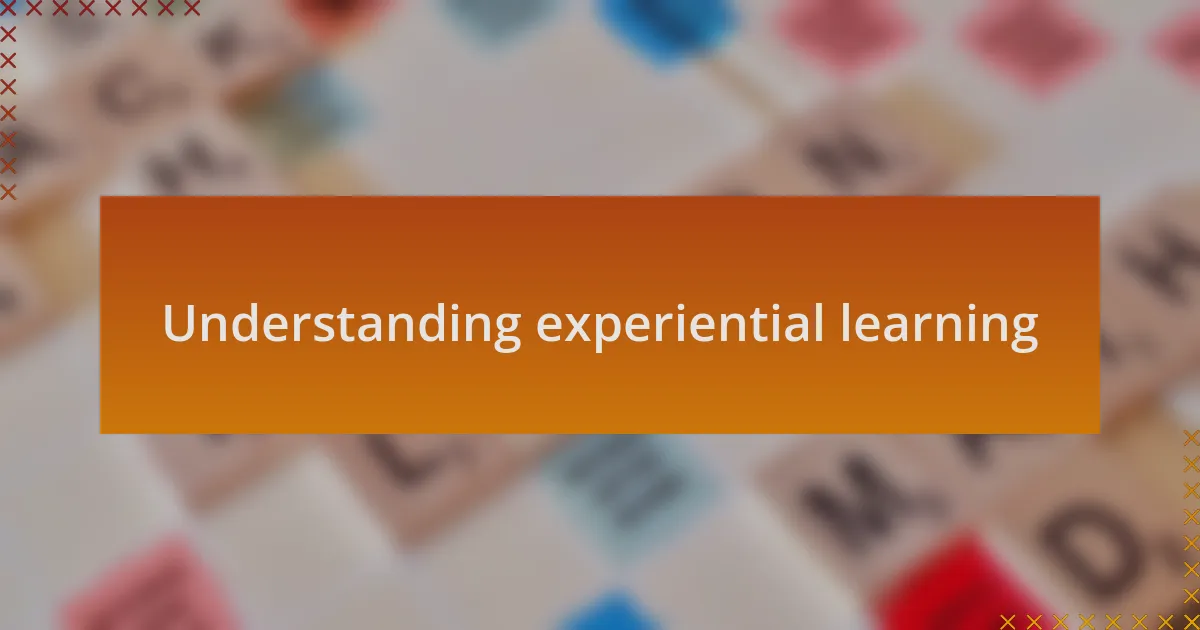
Understanding experiential learning
Experiential learning is all about diving into the experience and reflecting on it to gain insights. I remember when I first engaged in hands-on learning through a community project; the lessons I took away felt far more impactful than any lecture. Isn’t it fascinating how much we can learn when we immerse ourselves in real-world situations?
This approach often challenges traditional perceptions of education, where knowledge is typically seen as something simply transferred from teacher to student. I often wonder, how many crucial skills do we miss out on by simply sitting in a classroom? In my experience, the moments that truly stick with us come from moments of engagement and self-discovery rather than passive listening.
Moreover, experiential learning cultivates critical thinking and problem-solving skills. During one project, I encountered an unforeseen challenge that forced me to think creatively and adapt my strategy. Can you recall a time when an unexpected situation pushed you to think outside the box? The rush of discovering your own solutions can transform the learning process into a deeply personal journey.
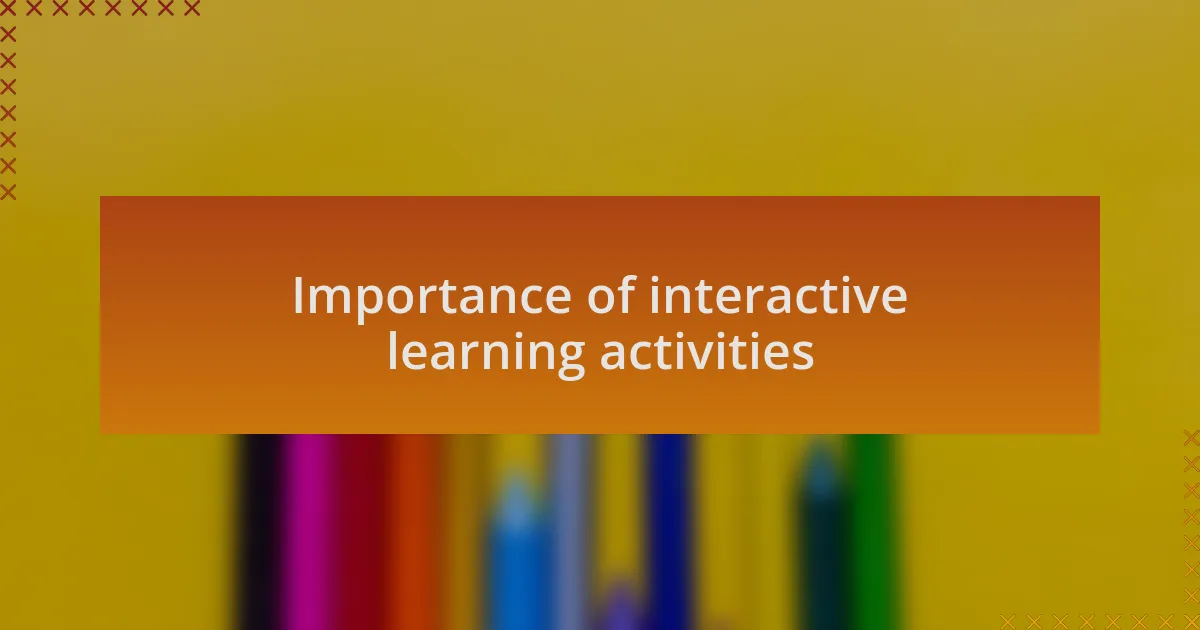
Importance of interactive learning activities
Interactive learning activities play a vital role in enhancing engagement and retention. I vividly recall a time when I facilitated a group activity that involved role-playing scenarios; the energy in the room was palpable. Seeing participants fully immersed in their roles made me realize how much more they absorbed compared to a straightforward lecture. Have you ever been part of an activity that just clicked?
Beyond mere engagement, these activities foster collaboration and communication skills. I once participated in a project where we had to solve a case study in small teams. The exchange of ideas and perspectives not only deepened our understanding but also built camaraderie. Think about how often teamwork becomes essential later in life—why not cultivate that skill through interactive learning?
Moreover, interactive learning activities spark creativity by allowing learners to explore concepts in diverse ways. I’ve always found that when engaged in hands-on activities, my mind begins to wander and more innovative ideas emerge. Isn’t it intriguing how creativity flourishes in less structured environments? By incorporating interactive elements, we nurture a space where learners can experiment, reflect, and ultimately innovate.
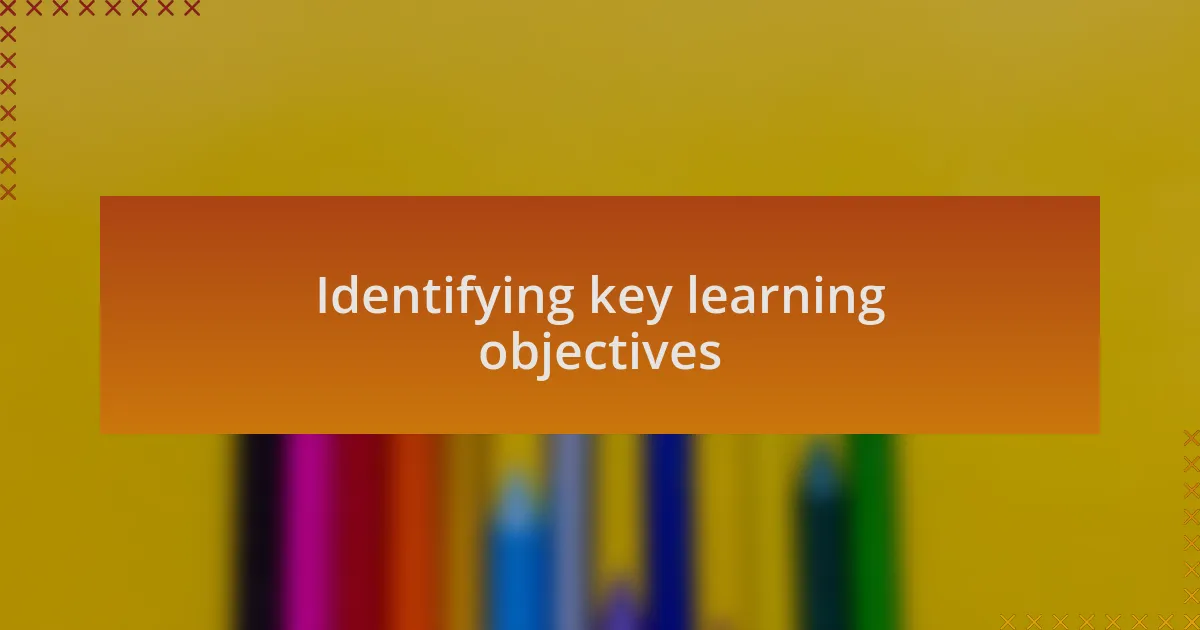
Identifying key learning objectives
Identifying key learning objectives is a crucial first step in crafting effective interactive learning activities. I remember sitting down with a group to brainstorm what we genuinely wanted our participants to achieve. It was enlightening to see how, when we focused on clear goals—like improved problem-solving skills—the entire activity design shifted, leading to a more targeted and impactful experience.
When I think about specific objectives, I often consider the balance of knowledge, skills, and attitudes we want to cultivate. For instance, in one workshop, we aimed not just to introduce a new concept but also to shape learners’ attitudes towards innovation. I found that articulating these objectives clearly at the outset helped the participants understand the importance of their engagement. How can anyone invest in their learning if they don’t see the purpose behind it?
Additionally, I’ve learned that flexibility is key when defining learning objectives. Sometimes what we think is essential shifts during the interactive session. I once pivoted my objectives mid-activity based on group discussions and observations. The realization that the learners were eager to dive deeper into a specific topic made me adjust my approach and thus enriched the learning experience. Being adaptable ensures that we meet learners where they are, doesn’t it?
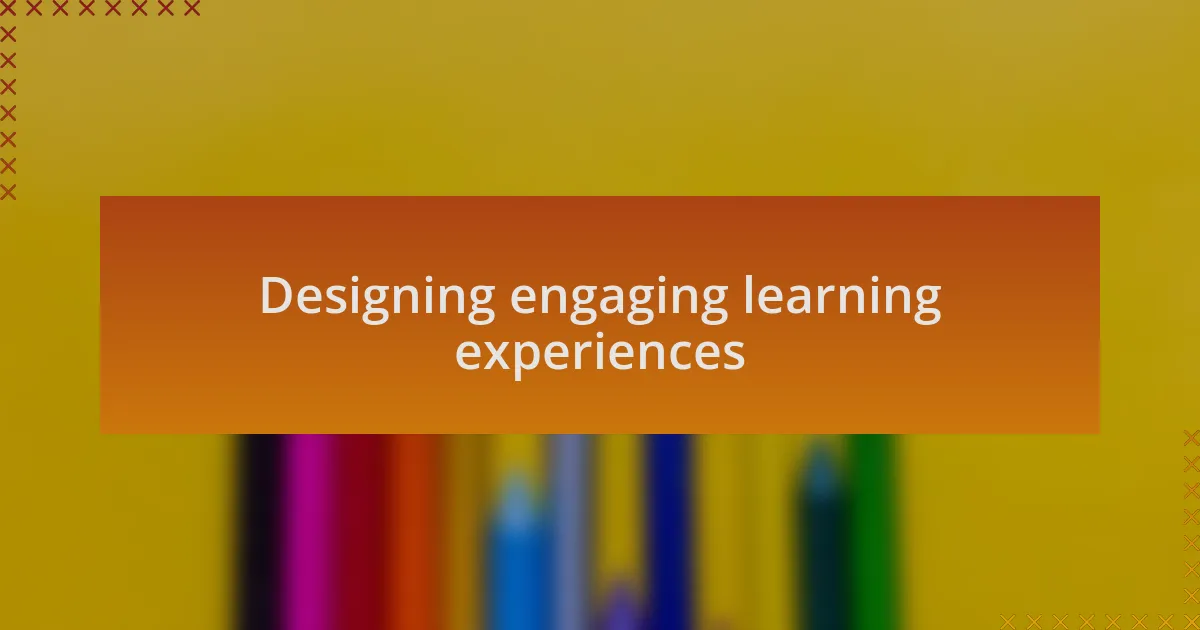
Designing engaging learning experiences
Creating engaging learning experiences requires a deep understanding of the participants’ backgrounds and interests. I recall a workshop where I asked everyone to share a personal story related to the topic. This exercise not only broke the ice but also revealed common threads among participants that I could weave into the learning materials. It’s amazing how learning becomes more relevant when it’s anchored in real-life contexts. Have you ever noticed how stories can spark connection and curiosity?
In my experience, incorporating active participation elevates engagement significantly. During one experiential project, I infused game-like elements into the learning activities. Each small group was tasked with solving a challenge, and those competitive dynamics transformed the atmosphere. Watching learners become animated and enthusiastic about problem-solving in teams was such a rewarding sight! Doesn’t it make you think how play can deepen understanding?
To truly resonate with learners, I believe we should solicit continuous feedback throughout the experience. I remember a session where I paused for input during an activity. The insights were invaluable—it not only showed me what resonated, but also empowered the participants to take ownership of their learning. Isn’t it fascinating how involving learners in the design process enriches the entire experience?
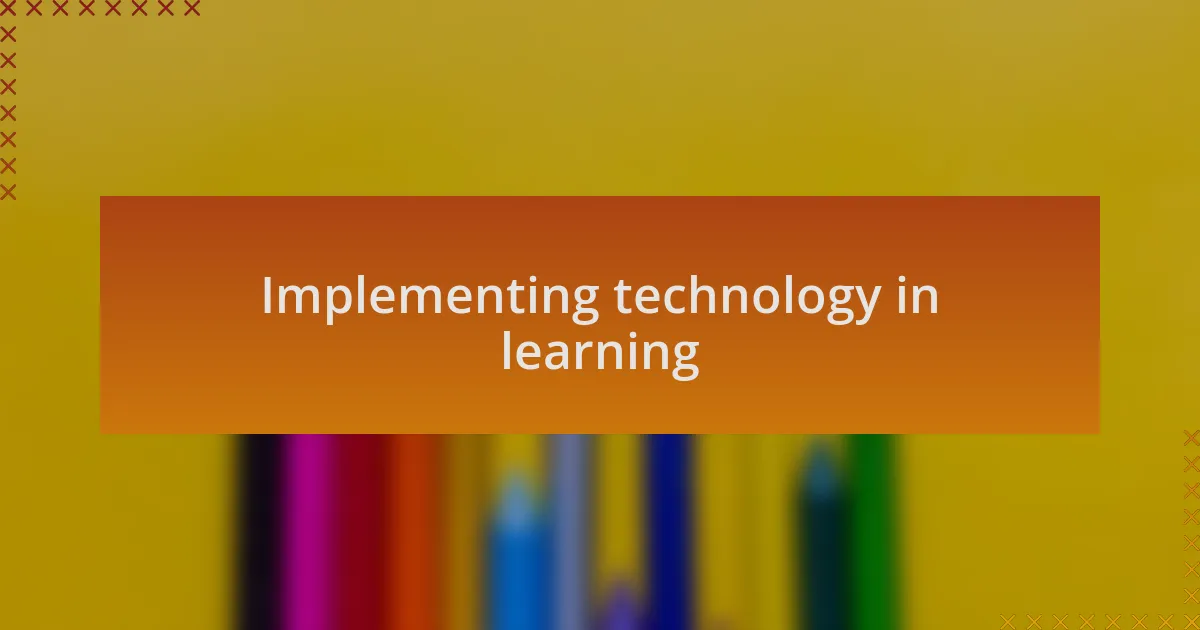
Implementing technology in learning
Integrating technology into learning transforms how we access and engage with information. I remember one time I introduced a virtual reality (VR) experience into a training session. The moment participants donned the headsets, the excitement was palpable. Suddenly, complex concepts came to life; it was like stepping into another world. Have you ever felt that sense of wonder when technology brings something directly into your experience?
I’ve also found that online collaborative tools can significantly enhance group dynamics. During a recent project, I used a shared digital whiteboard where participants could brainstorm in real-time. Watching their ideas flow instantly, regardless of location, was a game changer. It highlighted how technology not only connects people, but it also fosters creativity. Don’t you think it’s remarkable how a simple digital tool can bridge gaps?
Furthermore, data analytics can offer insights that were previously unattainable in traditional learning environments. I once analyzed participation trends using an online learning platform, and the results were eye-opening. It helped me fine-tune my approach and personalize future sessions. Isn’t it empowering to have such information at our fingertips, shaping a more effective learning journey?
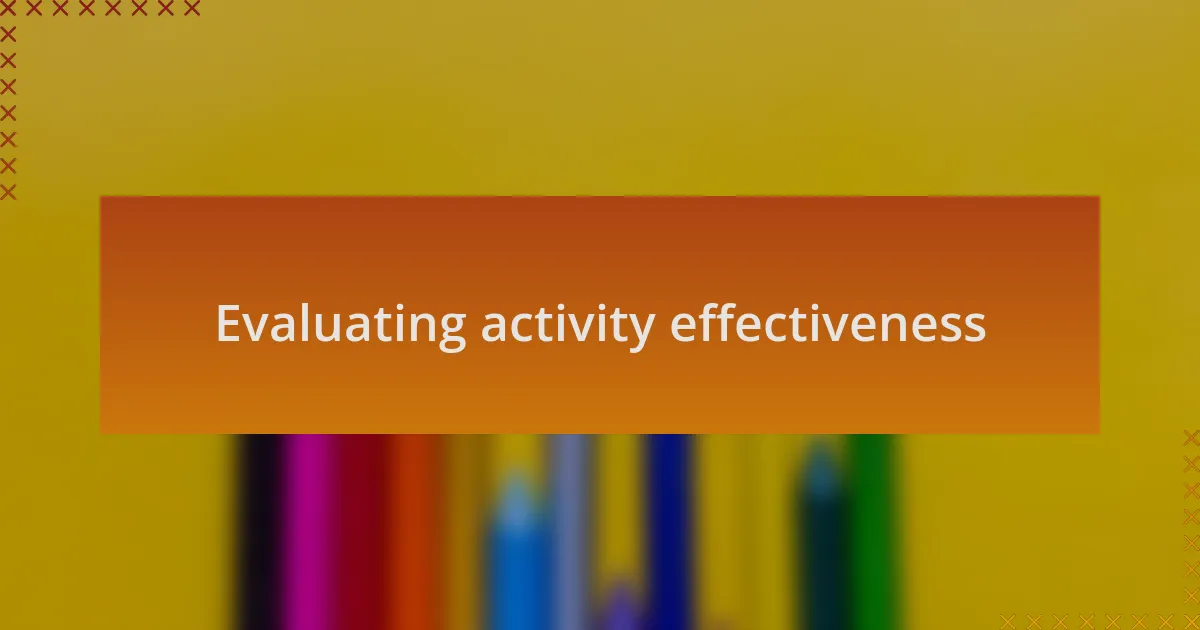
Evaluating activity effectiveness
When it comes to evaluating activity effectiveness, I’ve learned that feedback is essential. After a recent interactive workshop, I distributed a simple survey asking participants what resonated with them most. The genuine responses I received revealed not only what worked but also areas for improvement. How often do we overlook such valuable feedback in our eagerness to move forward?
Beyond gathering feedback, I also pay close attention to engagement levels during activities. I’ve noticed that in sessions where participants were more active and vocal, the retention of information was significantly higher. It begs the question: what strategies can we employ to keep learners engaged? By observing their body language and participation, I can refine each subsequent activity for maximum impact.
Data analysis plays a huge role in understanding effectiveness too. In one instance, I tracked completion rates on various activities and found surprising patterns. Activities that included gamification elements saw a staggering increase in engagement. Isn’t it fascinating how analyzing data can lead to actionable insights that truly enhance learning experiences?

Reflecting on personal experiences
Reflecting on my personal experiences, I’ve often found that the moments of true learning come from the least expected places. I recall a time during a team-building exercise where we were tasked with solving a puzzle without verbal communication. Initially, it felt frustrating, but I discovered a renewed appreciation for non-verbal cues, which deepened my understanding of collaboration. How often do we get caught up in our usual communication methods and miss out on these powerful lessons?
One particularly enlightening experience occurred when I facilitated a role-playing scenario. As participants stepped into different roles, I saw their emotions shift—from skepticism to genuine empathy. This transformation illuminated how immersive experiences can expand our emotional intelligence, leading to richer interactions. I wondered, how might this understanding influence our approach to real-world challenges outside the classroom?
The beauty of reflection lies in its ability to foster growth. After each activity, I take a moment to ponder what resonated with me personally. For instance, after an interactive storytelling session, I felt the weight of each participant’s story. It was a poignant reminder that sharing experiences can cultivate understanding and connection. Reflecting on such moments has shaped how I design activities, ensuring they resonate on a deeper level with others.